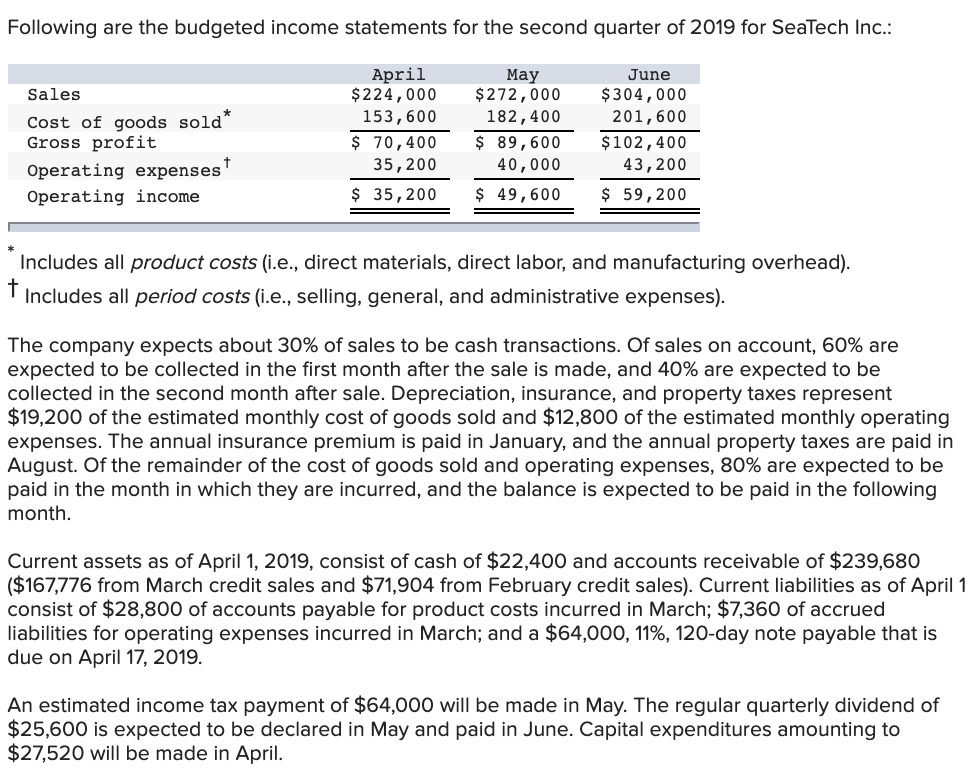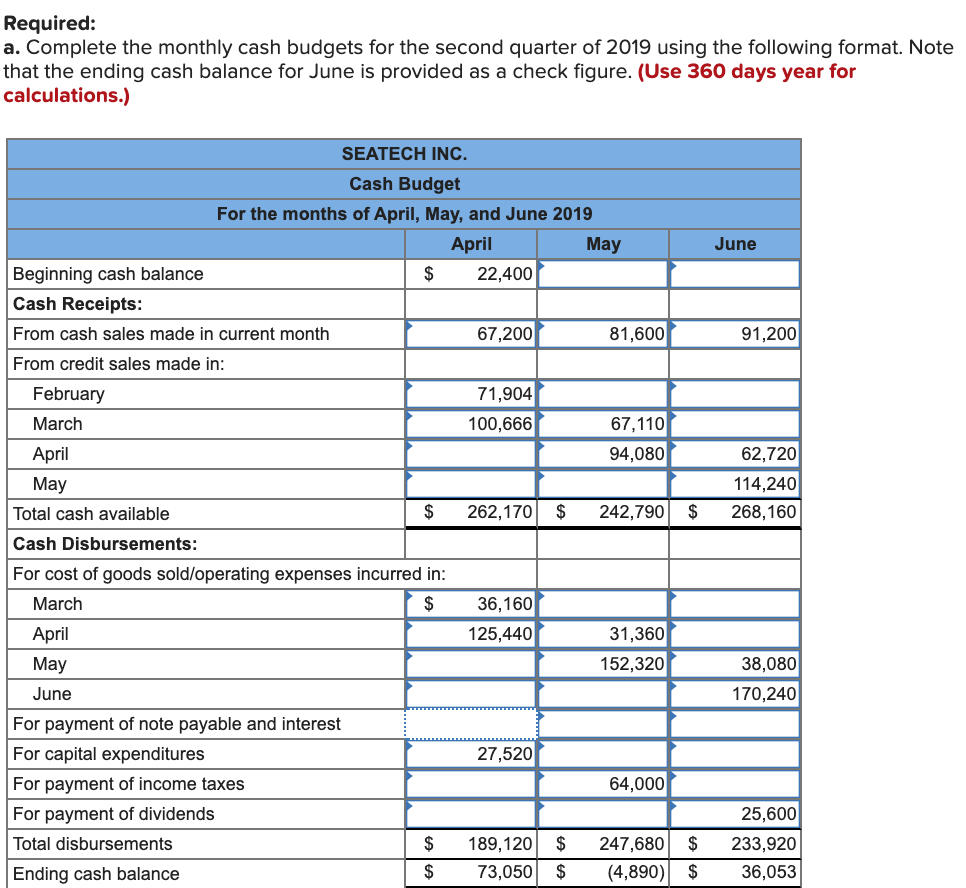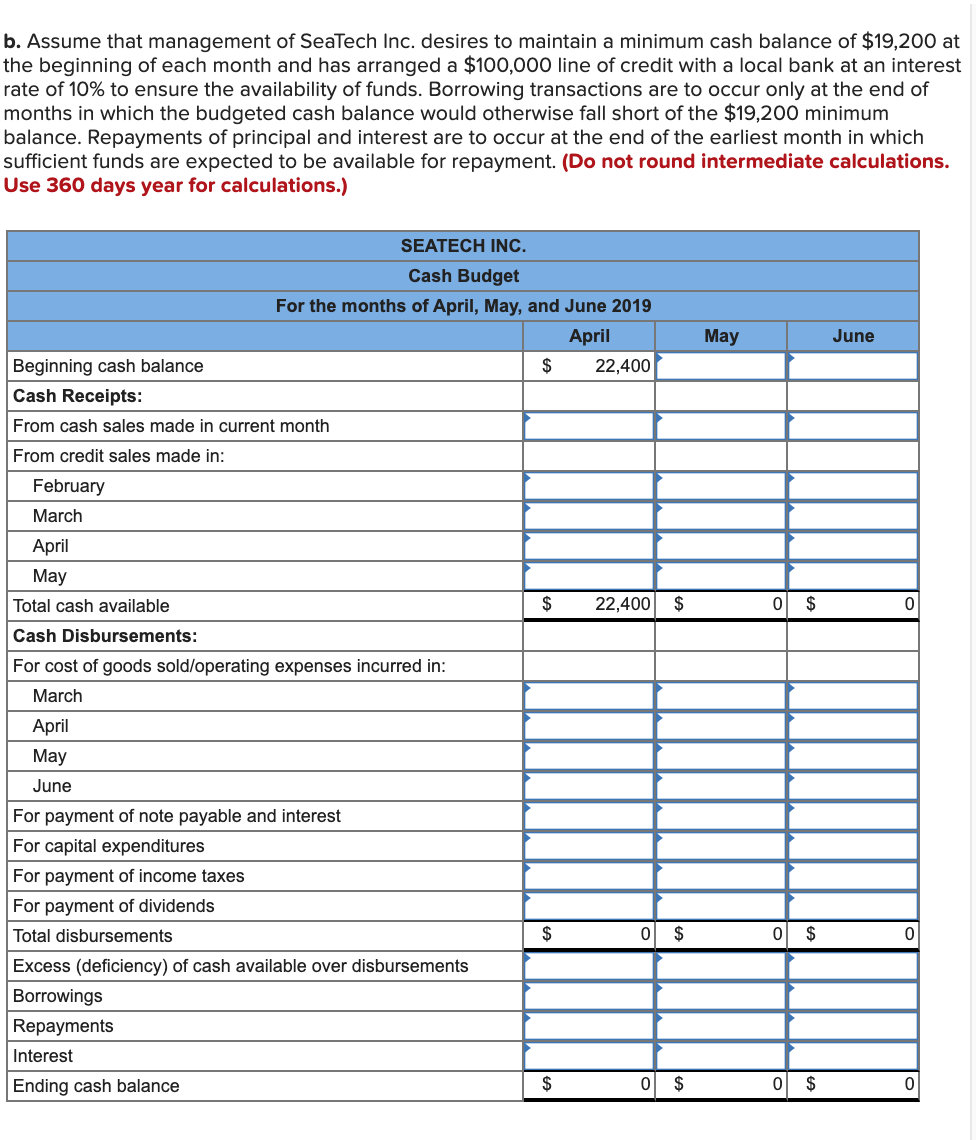 The filled-in spots on the chart are correct
The filled-in spots on the chart are correct


Following are the budgeted income statements for the second quarter of 2019 for SeaTech Inc.: Sales Cost of goods sold* Gross profit Operating expenses Operating income April $ 224,000 153,600 $ 70,400 35, 200 May $ 272,000 182,400 $ 89,600 40,000 June $304,000 201,600 $102,400 43,200 f $ 35, 200 $ 49,600 $ 59, 200 Includes all product costs (i.e., direct materials, direct labor, and manufacturing overhead). t Includes all period costs (i.e., selling, general, and administrative expenses). The company expects about 30% of sales to be cash transactions. Of sales on account, 60% are expected to be collected in the first month after the sale is made, and 40% are expected to be collected in the second month after sale. Depreciation, insurance, and property taxes represent $19,200 of the estimated monthly cost of goods sold and $12,800 of the estimated monthly operating expenses. The annual insurance premium is paid in January, and the annual property taxes are paid in August. Of the remainder of the cost of goods sold and operating expenses, 80% are expected to be paid in the month in which they are incurred, and the balance is expected to be paid in the following month. Current assets as of April 1, 2019, consist of cash of $22,400 and accounts receivable of $239,680 ($167,776 from March credit sales and $71,904 from February credit sales). Current liabilities as of April 1 consist of $28,800 of accounts payable for product costs incurred in March; $7,360 of accrued liabilities for operating expenses incurred in March; and a $64,000, 11%, 120-day note payable that is due on April 17, 2019. An estimated income tax payment of $64,000 will be made in May. The regular quarterly dividend of $25,600 is expected to be declared in May and paid in June. Capital expenditures amounting to $27,520 will be made in April. Required: a. Complete the monthly cash budgets for the second quarter of 2019 using the following format. Note that the ending cash balance for June is provided as a check figure. (Use 360 days year for calculations.) SEATECH INC. Cash Budget For the months of April, May, and June 2019 April May Beginning cash balance $ 22,400 Cash Receipts: From cash sales made in current month 67,200 81,600 June 91,200 71,904 100,666 From credit sales made in: February March April May Total cash available 67,110 94,080 62,720 114,240 268,160 $ 262,170 $ 242,790 $ Cash Disbursements: 36,160 125,440 31,360 152,320 38,080 170,240 For cost of goods sold/operating expenses incurred in: March $ April May June For payment of note payable and interest For capital expenditures For payment of income taxes For payment of dividends Total disbursements $ Ending cash balance $ 27,520 64,000 $ 189,120 73,050 247,680 $ (4,890) $ 25,600 233,920 36,053 $ b. Assume that management of SeaTech Inc. desires to maintain a minimum cash balance of $19,200 at the beginning of each month and has arranged a $100,000 line of credit with a local bank at an interest rate of 10% to ensure the availability of funds. Borrowing transactions are to occur only at the end of months in which the budgeted cash balance would otherwise fall short of the $19,200 minimum balance. Repayments of principal and interest are to occur at the end of the earliest month in which sufficient funds are expected to be available for repayment. (Do not round intermediate calculations. Use 360 days year for calculations.) May June SEATECH INC. Cash Budget For the months of April, May, and June 2019 April Beginning cash balance $ 22,400 Cash Receipts: From cash sales made in current month From credit sales made in: February March April May Total cash available $ 22,400 Cash Disbursements: For cost of goods sold/operating expenses incurred in: March $ 0 $ 0 April May June $ 0 $ 0 $ 0 For payment of note payable and interest For capital expenditures For payment of income taxes For payment of dividends Total disbursements Excess (deficiency) of cash available over disbursements Borrowings Repayments Interest Ending cash balance $ 0 $ 0 $ 0
 The filled-in spots on the chart are correct
The filled-in spots on the chart are correct







